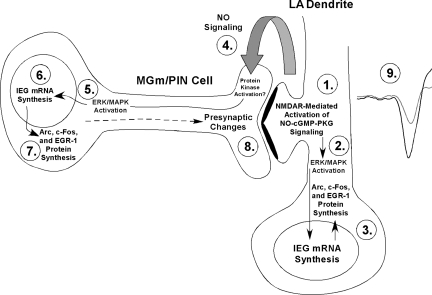Figure 8.
A model of fear memory consolidation. Fear memory consolidation is hypothesized to involve both pre- and postsynaptic modifications at thalamo-LA synapses. These modifications are first triggered by NMDAR-mediated alterations in protein kinase signaling pathways in LA neurons (Step 1) that promote ERK-dependent signaling in LA neurons (Step 2). Signaling via ERK/MAPK in LA neurons, in turn, promotes the transcription of IEGs including Arc/Arg3.1, c-Fos, and EGR-1 (Step 3), which is ultimately thought to lead to postsynaptic functional and/or structural changes that contribute to the formation of the memory. Concurrently, NMDAR-driven synaptic plasticity in LA neurons is also hypothesized to lead to the activation of nNOS in LA neurons and the release of nitric oxide (NO; Step 4), which can, in turn, engage ERK-driven signaling (Step 5) and mRNA synthesis (Step 6), followed by translation of IEGs including Arc/Arg3.1, c-Fos, and EGR-1 in MGm/PIN neurons (Step 7). ERK-driven gene expression in MGm/PIN neurons is, in turn, hypothesized to promote presynaptic functional and/or structural changes at thalamo-LA synapses (Step 8). Together with the postsynaptic modifications driven by ERK signaling in the LA, these presynaptic modifications act to strengthen the connectivity of thalamo-LA synapses, which is reflected neurophysiologically in an enhanced response to the CS in the LA after training (Step 9).

